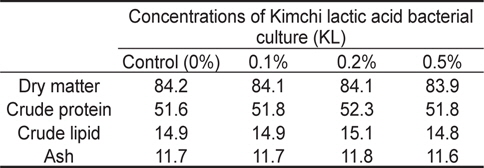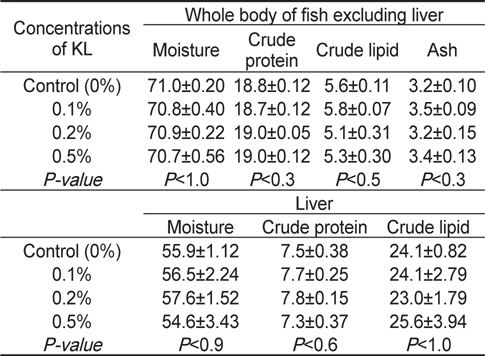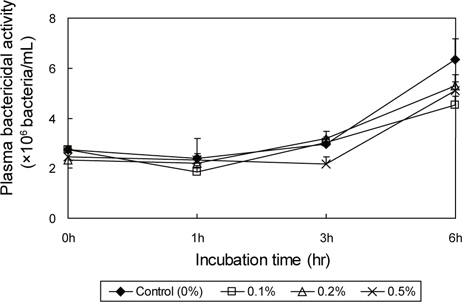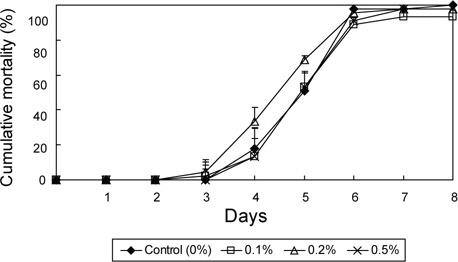



This study was performed to determine effects of the supplementation of Kimchi lactic acid bacterial culture in extruded pellets (EP) on the growth, body composition, blood chemistry and immune response of olive flounder
넙치는 성장이 빠를 뿐만 아니라 질병에 대한 내병성이 높아서 국내 해산어 양식산업에 있어서 양식생산양이 가장 높을 뿐만 아니라 그 가치 면에 있어서 가장 중요한 어종 중의 하나이다(KOSIS 2013). 따라서 넙치에 있어서 사료내 영양소 요구량(Lee et al. 2002; Kim and Lee 2004), 사료공급전략(Kim et al. 2002a; Cho 2005; Cho et al. 2006b), 일일사료공급율(Cho et al. 2006a, 2007a; Kim et al. 2009), 사료내 어분대체를 위한 동물성 및 식물성단백질원 대체 효과(Kikuchi et al. 1994, 1997; Kikuchi 1999a, 1999b; Kim et al. 2011) 등에 대한 다양한 연구가 수행된 바 있다.
그리고 사료첨가제로서 어보산(Kim et al. 1998; Lee et al. 1998; Kim et al. 2000), 황금(
김치 유산균 배양물을 육상동물인 돼지사료에 첨가 공급시 이들의 성장과 사료 이용성이 개선된다고 보고 된 바 있다(Han 2006). 따라서 본 연구에서는 김치 유산균 배양물을 넙치 양식에 적용시켜 넙치용 사료첨가제로서 개발 가능성과 이들의 사료내 공급시 넙치 어체의 근육 품질 개선 효과 및 세균(
본 실험에서 사용된 넙치 치어는 경북 울진에 위치한 개인 양어장에서 구입하여 사육실험 환경에 2주간 적응시켰으며, 적응기간 동안에는 1일 2회 충분한 양의 넙치 부상용배합사료(수협사료: 조단백질 함량 52% 및 조지질 함량 12%)를 공급하여 주었다. 넙치 치어[시작시 평균 무게(Mean±SD: 16.1±0.02 g)] 40마리씩을 12개의 180 L 유수식 수조(수량: 150 L)에 각각 수용하였다. 각 수조당 환수량은 9.4 L/min이었으며, 모래 여과된 자연해수를 공급하여 주었고 각각의 수조에는 aeration을 시켜주었다. 사육기간 동안의 수온은 10.0℃-24.5℃ (Mean±SD: 20.6±3.93℃)의 범위이었으며, 광주기는 자연 광주기를 따랐다.
본 사육실험에 사용된 사료는 부상용배합사료(수협사료)를 이용하였다. 실험에는 총 4가지 농도[대조구(무첨가구, Control), 0.1%, 0.2% 및 0.5% 김치 유산균 배양물 첨가구]의 김치유산균 배양물(Kimchi lactic acid bacteria culture, KL)을 첨가한 사료를 준비하였으며, 각 실험구는 3반복구를 두었다. 실험에 이용된 김치 유산균 배양물은 Leuconostock Kimchi를 포함한 김치유산균 혼합 배양물로서 상업적으로 시판되고 있는 제품(KimchiStoc®-LS, Tri-on International Corp, Seoul, Korea)을 사용하였다. 부상용배합사료 양의 각각 0%, 0.1%, 0.2% 및 0.5% 농도의 김치 유산균 배양물을 사료양 10% 농도의 증류수에 희석시킨 이후에 부상용배합사료와 잘 섞어주면서 10분간 충분히 침지시켜 각 농도의 김치 유산균 배양물이 흡착된 사료를 준비하였다. 각 농도별 김치 유산균 배양물이 흡착된 부상용배합사료의 일반성분 분석 결과는 Table 1에 나타내었다.
[Table 1.] Proximate composition (%) of the experimental diets

Proximate composition (%) of the experimental diets
김치 유산균 배양물을 흡착시킨 부상용배합사료는 -25℃ 냉동고에 보관하면서 필요시 마다 소량씩 사용하였으며, 주일마다 사료를 새로이 흡착시켜서 공급해 주었다. 사료공급은 1일 2회(08:00 및 17:00) 손으로 만복 시까지 공급하여 주었으며, 사료공급 30분 이후 각 수조에 남은 사료를 수거하여 사료섭취량으로부터 빼주었다. 넙치의 사육실험은 총 8주간이었다.
실험사료와 8주간의 사육실험 종료시 각 수조당 생존한 넙치 5마리씩을 무작위로 샘플하여 일반성분 분석에 이용하였으며, 수분, 조단백질, 조지질 및 회분을 AOAC (1990)의 표준방법에 따라서 분석하였다.
8주간의 사육실험 종료시 1일간 절식시킨 이후 각 수조에서 생존한 넙치를 무작위로 3마리씩 샘플하여 50 ppm의 아미노안식향산 에틸수용액으로 마취한 후, 미부정맥에서 채혈하여 혈청을 분리하였으며, 분리된 혈청을 이용하여 혈액성상 분석 및 면역능 실험에 사용하였다.
넙치의 혈청성분은 Automatic Chemistry System (HITACHI 7180/7600-210, Hitachi, Japan)을 이용하여 총단백질(total protein), glucose, glutamic oxaloacetic transaminase (GOT), glutamic pyruvic transaminase (GPT), cholesterol, triglyceride 및 total lipid 함량을 측정하였다.
라이소자임 활성은 Parry et al. (1965)의 turbidimetric method를 이용하여 측정하였다. 즉,
혈청 내 보체에 의한 세균 살해능의 조사는 Yoo et al. (1992)의 방법에 따라서 실험하였다. 각 혈청은 GVB2+ (Gelatin veronal buffer: VB 200 mL, 0.03M CaCl2-2H2O 5 mL, 2% gelatin 50 mL, DW 740 mL, pH 7.4)를 사용하였다. 모든 시료는 GVB2+로 5배 희석한 후 6×106 cfu/mL로 조정된
8주간의 사육실험 종료시 각 실험수조에서 생존한 넙치를 무작위로 20마리씩 선택하여
각 측정 항목들은 One-way ANOVA 및 Duncan's multiple range test (Duncan 1955)로서 실험구간의 유의성을 검정하였으며, SAS version 9.2 (SAS Institute, Cary, NC, USA) 통계분석 program을 이용하여 분석하였다.
넙치 부상용 배합사료에 김치 유산균 배양물을 농도별로 흡착시켜 8주간 공급시 넙치의 생존율(%), 어체중 증가(g/fish) 및 일일성장율(SGR)을 Table 2에 나타내었다. 넙치의 생존율은 95.8-99.2%의 범위로서 김치 유산균 배양물 농도별에 따른 유의적인 차이는 없었다(
8주간의 사육실험 종료시 넙치의 사료섭취량(g/fish), 사료전환효율(feed efficiency ratio, FER), 단백질전환효율(protein efficiency ratio, PER), 단백질축적율(protein retention, PR), 간체장지수(hepatosomatic index, HSI) 및 비만도(condition factor, CF)는 Table 3에 나타내었다. 사료섭취량, 사료전환효율 (1.46-1.53), 단백질전환효율(2.79-2.96), 단백질축적율(54.4- 57.1), 간체장지수 및 비만도 모두 김치 유산균 배양물 농도별에 따른 실험구간의 유의적인 차이가 없었다(

Survival, weight gain (g/fish) and specific growth rate (SGR) of olive flounder Paralichthys olivaceus fed the extruded pellets containing the various concentrations of Kimchi lactic acid bacterial culture (KL) for 8 weeks

Feed consumption (g/fish), feed efficiency ratio (FER), protein efficiency ratio (PER), protein retention (PR), hepatosomatic index (HSI) and condition factor (CF) of olive flounder Paralichthys olivaceus fed the extruded pellets containing the various concentrations of Kimchi lactic acid bacterial culture (KL) for 8 weeks
본 연구에서 김치 유산균 배양물 첨가에 따른 넙치의 성장 개선 효과 또는 사료 이용성에 유의적인 개선 효과가 나타나지 않은 이유 중의 하나는 8주간의 사육실험 동안 넙치의 성장이 대조구를 포함한 모든 실험구에서 아주 빠르게 나타나서 김치 유산균 배양물 첨가 효과가 나타나지 않은 것으로 생각된다. 즉, 실험어의 성장이 아주 빠르게 나타나서 김치 유산균 배양물 첨가 효과가 가려진(masking) 것으로 생각된다. 김치 유산균 배양물 첨가에 따른 넙치의 성장과 사료 이용성의 개선 효과를 기대하기 위해서는 넙치의 성장이 빠른 시기보다는 성장이 느리거나 또는 저수온기와 같이 환경 스트레스가 많은 겨울철에 적용시키는 것이 바람직할 것으로 생각된다. 배합사료내 김치 유산균 배양물 첨가에 따른 넙치의 성장이나 사료 이용성 개선 효과가 나타나지 않은 다른 이유로는 실험에 이용된 배합사료의 품질이 아주 우수하여서 김치 유산균 배양물 첨가 효과가 가려진 것으로 생각되며, 이와 같은 첨가제의 효과를 유도하기 위해서는 실험에 사용되는 배합사료의 품질이 다소 불량일 경우 이들 첨가제 효과가 긍정적으로 나타날 수 있을 것으로 생각된다.
김치 유산균 배양물이 농도별로 흡착된 배합사료를 8주간 공급받은 넙치의 간을 제외한 어체 및 간의 일반성분 분석 결과를 Table 4에 나타내었다. 간을 제외한 전어체와 간의 수분, 조단백질, 조지질 및 회분의 함량은 김치 유산균 배양물 농도별에 따른 유의적인 차이가 없었다(

Proximate composition (%) of the whole body excluding liver and liver in olive flounder Paralichthys olivaceus fed the extruded pellets containing the various concentrations of Kimchi lactic acid bacterial culture (KL) for 8 weeks
8주간의 사육실험 종료시 넙치의 혈장 총단백질(total protein), glucose, GOT, GPT, cholesterol, triglycerides 및 총지질 (total lipid)의 함량 변화를 Table 5에 나타내었다. 측정된 모든 혈장 성분의 함량은 김치 유산균 배양물 첨가에 따른 실험구간의 유의적인 차이가 없었다(

Plasma chemistry of olive flounder Paralichthys olivaceus at the end of the 8-week feeding trial
농도별 김치 유산균 배양물이 흡착된 배합사료를 8주간 공급한 넙치의 혈장내 Lysozyme 활성 변화를 Fig. 1에 나타내었다. Lysozyme 활성은 0.1% 첨가구(425 units/mL), 0.5% 첨가구(325 units/mL), 대조구(275 units/mL) 및 0.2% 첨가구(175 units/mL)의 순으로 높게 나타났으나, 실험구간의 유의적인 차이는 없었다(
넙치 혈장의 세균 살해능 조사 결과는 Fig. 2와 같다. 배양 1시간째 모든 실험구는 일정하게 감소하다가 3시간째에는 0.5% 첨가구를 제외한 모든 실험구에서 증가하는 경향을 보였으나 0.5% 첨가구는 배양 3시간까지 감소하다가 6시간째 증가하였다. 그러나 각 시간별 김치 유산균 배양물 농도별에 따른 실험구간의 유의적인 차이는 나타나지 않았다(
8주간의 넙치 사육실험 종료시 무작위로 추출한 20마리의 넙치를
본 연구에서 김치 유산균 배양물 첨가에 따른 넙치의 생산성이나 사료 이용성 또는 인위적인 세균 감염성 향상에 개선 효과가 나타나지 않은 다른 이유로는 김치 유산균 배양물 첨가 효과는 종특이성(species-specific)이 있어서 돼지와 같은 항온동물에서는 효과가 있으나, 변온동물인 어류에서는 그 효과가 없을 수 있는 것으로 생각된다. 그리고 본 실험의 경우 일일성장율(SGR)이 아주 높게(3.3-3.4%/day) 나타난 것으로 미루어 보아 양질의 부상용배합사료가 실험에 이용된 것으로 추정되며 이로 인하여 김치 유산균 배양물 첨가에 따른 효과가 가려진 것(masking)이 추측 가능한 다른 이유이다. 또한 김치 유산균 배양물의 제조 공정 과정에 따른 유산균 첨가 효과가 다르게 나타나기 때문에 보다 자세한 연구가 필요한 것으로 생각된다.
이상의 결과를 고려할 때 본 연구의 조건에서는 김치 유산균 배양물의 부상용배합사료에 흡착시 넙치의 성장, 사료 이용성, 혈액성상학적 변화, lysozyme 활성 및







